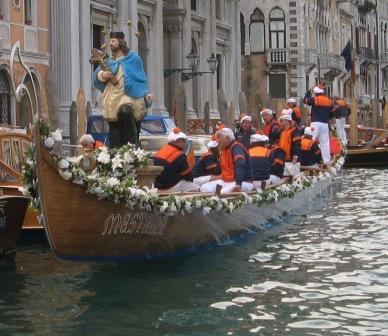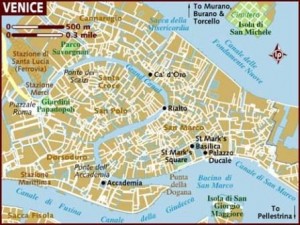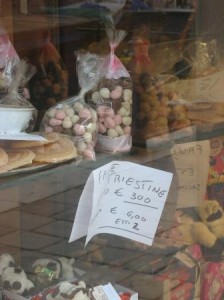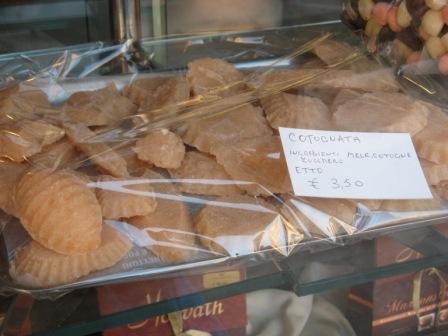November 1st and 2nd pack a one-two punch here, though the first is a holiday and the second isn’t (every year I struggle to remember that because it seems wrong to me). (I think they should both be holidays.)

November 1 is All Saints Day — shortened here to “i santi” (“the saints”). There is no special way of observing this feast, other than going to church which for some people is asking too much. I know men who will proudly tell you that they haven’t been to church (or put on a tie) since their wedding day. Strangulation seems to be the theme.

November 2 is All Souls Day — shortened here to “i morti” (“the dead”). This is a day (even if it isn’t a holiday) which Venetians observe with more attention. The vaporetto to the island of San Michele, the cemetery island, is free. In the not-so-old days, within Lino’s memory, a bridge on boats was constructed for the day from the Fondamente Nove to the island (a distance visibly shorter than the Giudecca Canal, whose bridge for the feast of the Redentore was also on boats). Many people make a point, at least once a year, of visiting their relatives’ graves, tombs, loculi, and if you’re ever going to go, this is the day. The florists on the Fondamente Nove make some real money.

I’ll write more about death in Venice some other time — it’s an interesting subject about which there is plenty to say, partly because of the age of the population. Funeral homes are probably one of the few businesses here that are immune to the global economic situation.
The traditions still associated with this feast-day naturally have mostly to do with food. For about a week before November 2, the pastry-shops and cafes put on sale little bags of what appear to be roundish colored styrofoam blobs, like lumpy cherries, colored white, pink, or brown. These are called “fave” (FAH-veh) and come in either the small (Trieste) form or the larger (Venice) form. It’s inexplicable to me but the Triestine are everywhere. Seeking a sack of Venetian fave will cost you some time and effort.
There are differing recipes, but the one I picked had only three ingredients: powdered pinoli nuts, sugar, and egg white, baked for an hour at low temperature. For the record, I tried making them yesterday and while the simplicity of the recipe was part of its appeal, I can confirm that if you halve the recipe, you’d better make an effort to halve the egg white. They were a spectacular failure.
However, from one of my favorite Venetian cookbooks, A Tola co i Nostri Veci by Mariu’ Salvatori de Zuliani, comes a recipe that makes more sense.
First of all, he makes the point quite firmly that coloring the fave is a newfangled fad; the classic Venetian version is always plain white. Remember that if you want to be a purist.
Venetian Fave for All Souls Day (November 2)

200 gr almonds, 300 gr sugar, 125 gr flour, pinch of ground cinnamon, 20 gr butter, 2 whole eggs, lemon zest.
Leave the “peel” on the almonds and pound them in a mortar with the sugar, then sift. Add the flour, a pinch of cinnamon, butter, eggs, and the lemon zest and mix well with your hands.
Divide the mixture into blobs the size of walnuts, arranging them in lines on a baking sheet that’s been buttered and floured. Press each one lightly with your finger to flatten it slightly — the purpose is to make them resemble as much as possible the normal amaretto cookie.
Bake at “moderate heat” he says; I’ll take that to mean 150. He doesn’t say how long, either (I love the old-fashioned way of writing recipes).
Of course you have already been thinking, “But a fava is a kind of bean.” This is true. So why call these “beans” and why this particular composition, and why on the Day of the Dead?
The rituals associated with death are so ancient there’s a point where explanations fail, but offering food to the gods on certain occasions, especially death, goes back to when people were cooking on stones. In the Mediterranean a great deal of attention was paid to the cult of the Parche (as they were called in Rome), or Fates, who were the goddesses of destiny. (The Greeks also had them under the name of Moirai.) Nona spun the thread of an individual’s life, Decima measured its length, and Morta was the one who cut the thread. Hence they were revered as, among other things, the goddesses of death.
It became known (I always wonder exactly how) that the Parche especially like fava beans. There are undoubtedly reasons for this — I’m guessing spring and fertility, that seems to be what motivates many divinities. So since real fava beans are impossible to get this time of year, or have been — I suppose nowadays you could fly them in from Zanskar — these little nubbins were invented to symbolize them. Sweetness, I seem to recall, was also an important element of some funerary offerings; often honey was used, which also embodied a raft of symbolic meanings.
These fave don’t really have a flavor, unless you count sheer, unadulterated, industrial-strength sweetness as flavor. They’re pleasant enough in the mouth, but as they go down they sort of close up your throat behind them. After two and a half you won’t want any more till next year, and you’ll be vaguely sorry you ate that extra half.
Next year I’m going to try Zuliani’s version, and I hope the Fates will be kinder to me in the kitchen, if nowhere else.

